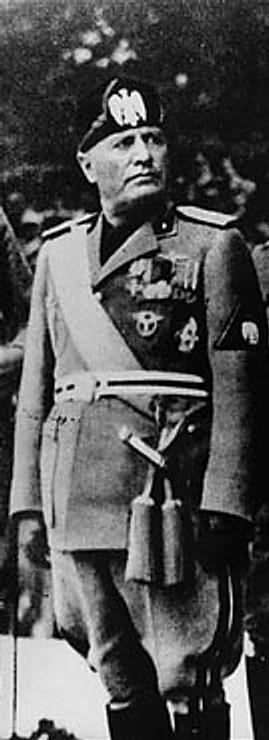Benito Mussolini
Benito Mussolini | |
|---|---|
 Benito Mussolini in Yugoslavia | |
| 27th Prime Minister of Italy | |
| In office 21 October 1922 – 24 December 1925 | |
| Monarch | King Victor Emmanuel III |
| Preceded by | Luigi Facto |
| Succeeded by | Himself, as Head of Government |
| Head of Government of the Kingdom of Italy and Duce of the Fascist Republic of Italy | |
| In office 24 December 1925 – 25 July 1943 | |
| Monarch | King Victor Emmanuel III |
| Preceded by | Himself, as Prime Minister |
| Succeeded by | Pietro Badoglio |
| Personal details | |
| Born | Benito Amilcare Andrea Mussolini Predappio, Emilia-Romagna Italy |
Benito Amilcare Andrea Mussolini (29 July 1883 - 28 April 1945) ruled Italy as a dictator from 1922 to 1943.
Biography
Early life (1883-1922)
Benito Mussolini was named after Benito Juarez, a Mexican opponent of the political power of the Roman Catholic Church, by his anticlerical (a person who opposes the political interference of the Roman Catholic Church in secular affairs) father. [1] Mussolini's father was a blacksmith[2]. Before being involved in politics, Mussolini was a newspaper editor (where he learned all his propaganda skills) and elementary school teacher[3].
At first Mussolini was a socialist, but when he wanted Italy to join the First World War he was thrown out of the socialist party. He 'invented' a new ideology, Fascism, much out of Nationalist and Socialist views.
Rise to power and becoming dictator (1922-1927)
In 1922, he took power by having a large group of men, "Black Shirts," march on Rome and threaten to take over the government. King Vittorio Emanuele III gave in, allowed him to form a government, and made him prime minister. In the following five years, he gained power, and in 1927 created the OVRA, his personal secret police force. Using the agency to arrest, scare, or murder people against his regime, Mussolini was dictator of Italy by the end of 1927. Only the King and his own Fascist party could challenge his power.
Fascism as practiced by Mussolini (1922-1943)
Mussolini's form of Fascism, "Italian Fascism"- unlike Nazism, the racist ideology that Adolf Hitler followed- was different and less destructive than Hitler's. Although a believer in the superiority of the Italian nation and national unity, Mussolini, unlike Hitler, is quoted "Race? It is a feeling, not a reality. Nothing will ever make me believe that biologically pure races can be shown to exist today".[4]
Mussolini wanted Italy to become a new Roman Empire. In 1923, he attacked the island of Corfu, and in 1924, he occupied the city state of Fiume. In 1935, he attacked the African country Abyssinia (now called Ethiopia). His forces occupied it in 1936. Italy was thrown out of the League of Nations because of this aggression. In 1939, he occupied the country Albania. In 1936, Mussolini signed an alliance with Adolf Hitler, the dictator of Germany.
Fall from power (1940-1945)
In 1940, he sent Italy into the Second World War on the side of the Axis countries. Mussolini attacked Greece, but he failed to conquer it. In 1943, the Allies landed in Southern Italy. The Fascist party and King Vittorio Emanuel III deposed Mussolini and put him in jail, but he was set free by the Germans, who made him ruler of the Italian Social Republic puppet state. When the war was almost over, Mussolini tried to escape to Switzerland with his mistress, Clara Petacci, but he was captured and shot by partisans. Mussolini's dead body was hanged upside-down, together with some of Mussolini's helpers, on a pole at a gas station in the village of Mezzegra, which is near the border between Italy and Switzerland.
After death
After the war, several Neo-Fascist movements have had success in Italy, the most important being the Movimento Sociale Italiano. His granddaughter Alessandra Mussolini has outspoken views similar to Fascism.
Sources
- ↑ Brendon, Piers The Dark Valley: A Panorama of the 1930s Vintage Books 2000 page 128
- ↑ Mussolini, Benito (1998) My Rise and Fall Da Capo Press page 3
- ↑ Mussolini, Benito My Rise and Fall Da Capo Press 1998 pages 11-12
- ↑ http://www.kennethbillings.org/mussolini.html 1941 book "Dictators and Democrats"

